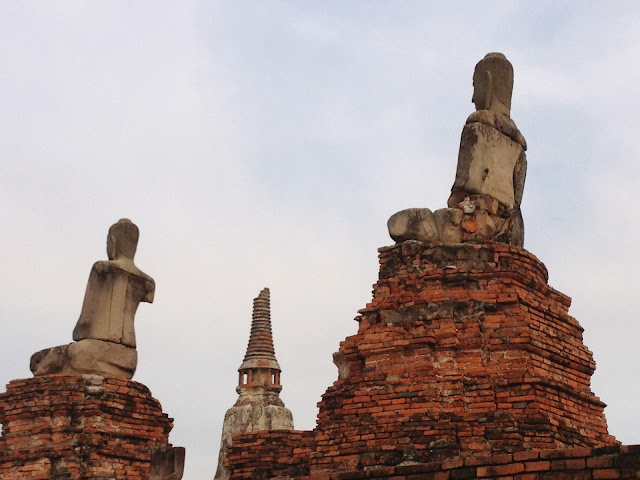The following is an ancient bell. It looks like a rock to me. I guess a rock, can be a bell, or a bell can be something other than something you ring.
The following I got into trouble for photographing. I didn't realize there was no photography in this room of the museum. Oops. These are the relics recovered from Wat Phra Mahathat. When a Wat has the title Mahathat, there is a relic of the Buddha interred at the Wat. Archeologists recovered this relic 17m below the main stupa and the ornate package surrounding it to great fanfare in 1956. I can't remember exactly, but I think the first and largest stupa was lead, next silver, then a gold alloy, Next ebony with a gold top, and then redwood. Last was a gold and gem encrusted stupa that held a tiny speck 1/8 the size of a rice seed. Relics would often be bones, teeth, hairs of Buddha, and it is believed that they can create a clone of themselves. Very Indian Jones.
At the National Museum in Bangkok free tours in English are offered on Wednesday and Thursday mornings at 9:30. I highly recommend this. In fact it might just be the best thing you can do in Bangkok. I learned more here, from my wonderful guide on our 3 1/2 hour tour, then from any other place or book. I will share some of this knowledge in this blog. For example, the meaning of the color red in Thai culture. Here in the mural below, you see a red lighting bolt shape surrounding Buddha. The red is supposed to 1) invisible and 2) it draws attention to an important thing. Often the ceiling of a temple is painted red to signify that even within the walls of the temple, we are still connected to the universe.
The following shot barely captures the splendor of the royal pyres used for funerals of royals. Again, you see the Naga. A LOT OF THEM! With crystal eyes and colored mirrors and gilded scales. And this is real gold leaf. They were restored last year with gold leaf and q-tips. They are pulled by men dressed in red. That is because the red makes them invisible, and it looks as if the royal pyre is floating in the air pulled by the naga. If you have a strong stomach check out the customs dealing with royal deaths in Thailand.
Those of you who know me know I love beads and rocks. Beads made out of rocks are cool too. Here on display are some very old beads from the U-Thong kingdom. This was located in the area of Suphanburi. This kingdom, later moved to form the Ayutthaya kingdom. Suphan Buri was where I lived for my first 10 weeks here in Thailand. It is where my Thai "family" live. While in Suphan Buri, I purchased a strand of these ancient beads. I love them, and wear them every day. Some are colored glass and some are agate.
Speaking of elephants, this god is Ganesh. Since learning some of his stories, I feel like I see him everywhere I look. He is a god who always says "yes" if you pray hard enough. Therefore, he is in many boys pockets as they ask a girl out. He is also the patron saint of arts. Therefore, my museum ticket had a symbol of Ganesh on it. The theater has a statue of Ganesh. Many places have Ganesh displayed. Thailand began as Hindu country, and later became Buddhist. Many of the gods of Hinduism are still seen. Here is a Shiva Lingum. Brahma and Vishnu are also represented by the eight and four sided shaft.
This is Garuda, the vehicle of Vishnu. Garuda is the national symbol of Thailand, so you see him on banks, and letterheads. He is also represented on Thai temples on each roof bargeboard as a eagle like shape.





























No comments:
Post a Comment